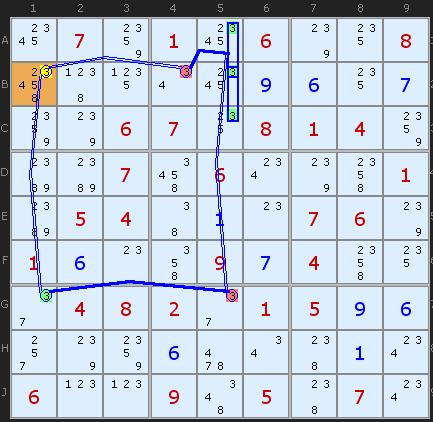How to Build Chains
This page is under construction in preparation for version 1.63 and 1.64 of the solver

The example is an X-Cycle on 3 starting and ending in B1.
A group is a set of two or three cells aligned on a row or column - and in the same box - which we can consider as a single cell for the purposes of our chain. Because they are aligned it a chain coming to them on the alignment doesn't need to care which, if any, are the solutions. In the example we are starting at B1 and going counter-clockwise - to G1 and then to G5. From G5 we can see the of 3s in [A5,B5,C5]. The alignment is critical. This won't be possible, in this example, coming from any other direction.
| In the chain G3 is OFF, so one of A5, B5 or C5 must be on because they are the only remaining 3s in the column. How, if we pretend to turn them all ON we turn off the 3 in B4 and continue the chain. B4 being off means 3 in B1 is on and we have established our contradiction. |
The solver returns
X-CYCLE on 3 (Grouped Discontinuous Alternating Nice Loop, length 6): +3[B1]-3[B4]+3[A5|B5|C5]-3[G5]+3[G1]-3[B1] - Contradiction: When B1 is set to 3 the chain implies it cannot not be 3 - it can be removed |

Comments